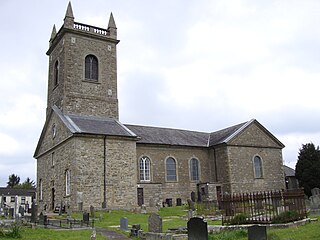
County Fermanagh is one of the thirty-two counties of Ireland, one of the nine counties of Ulster and one of six counties of Northern Ireland.

Enniskillen is the largest town in County Fermanagh, Northern Ireland. It is in the middle of the county, between the Upper and Lower sections of Lough Erne. It had a population of 14,086 at the 2011 Census. Enniskillen Castle was built in the 15th century as a stronghold of the Maguires, before coming under English control in the early 17th century. The castle and town were expanded during the Plantation of Ulster. It was the seat of local government for the former Fermanagh District Council, and is the county town of Fermanagh.

Lisnaskea is the second-biggest settlement in County Fermanagh, Northern Ireland. It is situated mainly in the townland of Lisoneill, with some areas in the townland of Castle Balfour Demesne, both in the civil parish of Aghalurcher and the historic barony of Magherastephana. It had a population of 3,020 people at the 2021 Census.

Irvinestown is a town in County Fermanagh, Northern Ireland. At the 2021 Census it had a population of 2,325 people. The most notable buildings are Necarne Castle, formerly known as Castle Irvine, and Castle Archdale. Irvinestown is situated within Fermanagh and Omagh district.

Crossgar is a village and townland in County Down, Northern Ireland. It is about 15 miles (24 km) south of Belfast – between Saintfield and Downpatrick. Crossgar had a population 1,997 people in the 2021 UK Census.

Clogher is a village and civil parish in the border area of south County Tyrone, Northern Ireland. It lies on the River Blackwater, 5.8 miles from the border crossing to County Monaghan. It stands on the townlands of Clogher Demesne and Clogher Tenements. The 2011 Census recorded a population of 717. The civil parish of Clogher covers areas of County Fermanagh as well as County Tyrone.

Dromore is a town, townland and civil parish in County Tyrone, Northern Ireland. It is nine miles (14 km) south west of Omagh on the A32 and sixteen miles (26 km) from Enniskillen. The population of Dromore was 1,198 at the 2011 Census.

Fintona, is a village and townland in County Tyrone, Northern Ireland. Its population at the 2011 Census was 1,164.

Belleek is a large village and civil parish in County Fermanagh, Northern Ireland. While the greater part of the village lies within County Fermanagh, part of it crosses the border and the River Erne into County Donegal. It lies in the historic barony of Lurg. It had a population of 904 people in the 2011 Census, and is situated within Fermanagh and Omagh district, around 7 kilometres (4 mi) east of Ballyshannon.

Castledawson is a village in County Londonderry, Northern Ireland. It is mostly within the townland of Shanemullagh, about four miles from the north-western shore of Lough Neagh, and near the market town of Magherafelt. In the 2011 Census, it had a population of 2,289.

Bellanaleck is a small village in County Fermanagh, Northern Ireland. It lies just south of Enniskillen on the main A509 (N3) road towards Cavan and Dublin. In the 2011 Census it had a population of 532. It is situated within Fermanagh and Omagh district.

Ederney is a village situated primarily in the townlands of Drumkeen and of Ederny in County Fermanagh, Northern Ireland.

Kesh is a village in County Fermanagh, Northern Ireland. It is on the Kesh River about 1 mile (1.6 km) from Lower Lough Erne. The 2011 Census recorded a population of 1,039 people. It is within Fermanagh and Omagh district.

Newtownhamilton is a small village and civil parish in County Armagh, Northern Ireland. It lies predominantly within Tullyvallan townland. The civil parish is within the historic barony of Fews Upper. In the 2011 Census it had 2,836 inhabitants.

Tempo, historically called Tempodeshel, is a small village at the foot of Brougher Mountain in County Fermanagh, Northern Ireland. The Census of 2011 recorded a population of 489 people. It lies within the Fermanagh and Omagh District Council area.
Martinstown is a small village in County Antrim, Northern Ireland. Located 6 miles from Ballymena, it is situated in Glenravel, locally known as "The Tenth Glen", alongside the widely known nine Glens of Antrim.

Desertmartin is a small village in County Londonderry, Northern Ireland. It is four miles from Magherafelt, at the foot of Slieve Gallion. In the 2001 Census the greater Desertmartin area had a population of 1,276. It lies within Desertmartin parish, Mid-Ulster District, and the historic barony of Loughinsholin. Neighbouring settlements include Draperstown, Magherafelt, Moneymore, and Tobermore.

Ballyronan is a village and townland in County Londonderry, Northern Ireland, on the north western shore of Lough Neagh. The village is 5 miles (8 km) from Magherafelt and 12 miles (19 km) from Cookstown. It is situated within Mid-Ulster District.

Roslea Shamrocks is a Gaelic football club based in Rosslea, County Fermanagh, Northern Ireland.

The Troubles of the 1920s was a period of conflict in what is now Northern Ireland from June 1920 until June 1922, during and after the Irish War of Independence and the partition of Ireland. It was mainly a communal conflict between Protestant unionists, who wanted to remain part of the United Kingdom, and Catholic Irish nationalists, who backed Irish independence. During this period, more than 500 people were killed in Belfast alone, 500 interned and 23,000 people were made homeless in the city, while approximately 50,000 people fled the north of Ireland due to intimidation. Most of the victims were Nationalists (73%) with civilians being far more likely to be killed compared to the military, police or paramilitaries.




















